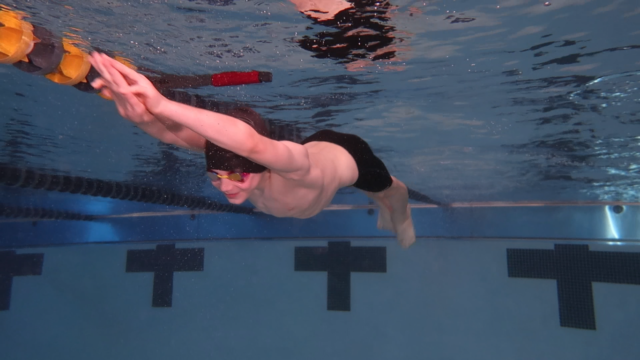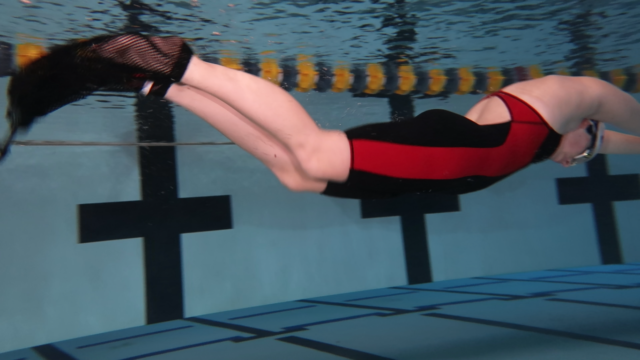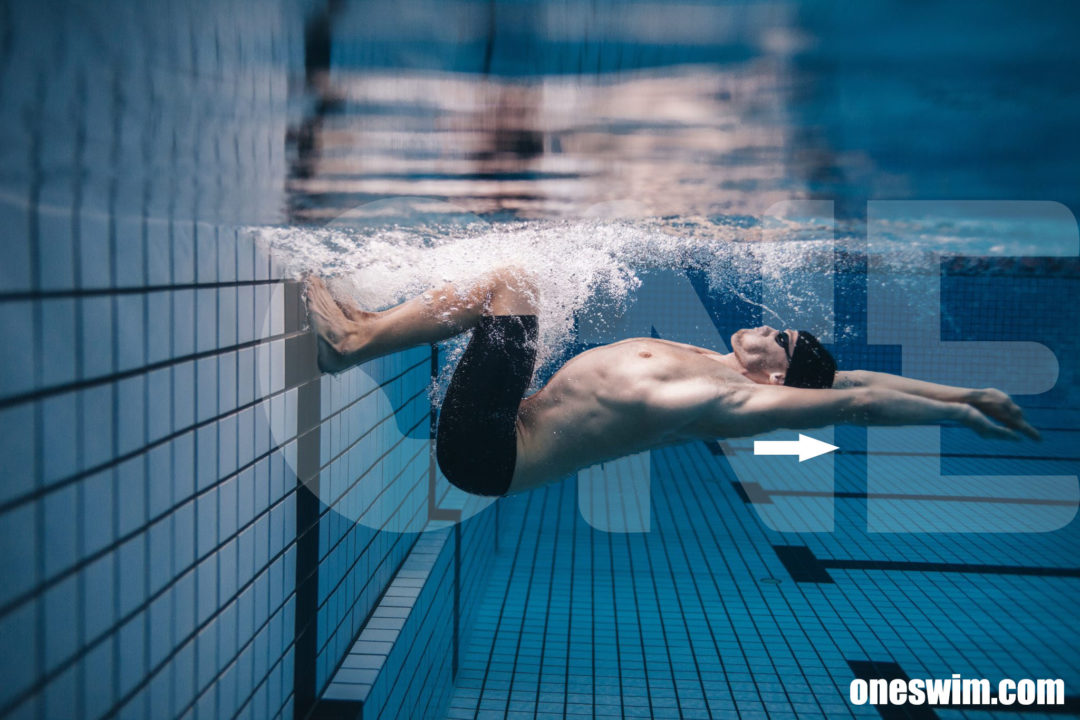courtesy of ONEswim.com, a SwimmersBest brand
Once your body has made the flip, any hesitation, any little last minute adjustments, any imbalance, every single micro change you need to make takes time… are you working on fixing those details or hoping your competitor has them too? In Part 1 of this article we reviewed some of the best ways to solve problems that most swimmers have with the approach into their flip turns. In Part 2 we are going to dig deep into the flaws that are caused in ‘setting up’ for a perfect, fast, and powerful streamlined push off the wall. Part 1 addressed how to get over fast. Part 2 will address what to do as your feet are hitting the wall.
Principal #1: Get into HYPER streamline instantly!
First video yourself or your swimmers and ask the hard questions about the details.
Red Flag Habits:
– What are both arms doing to set up for streamline? (should move straight into streamline)
– Are your feet at shoulder width as they hit the wall?
– Are you up on the balls of your feet with heels away from the wall?
– Are you waiting for your arms to get into streamline?
– Are you close enough to the wall that your knees are bent and ready to push?
The most common problem on the ‘back half’ of your flip turn are messy arms. When first learning our flip turns, it is important to have the arms exaggerate the ‘hat push’ (like pushing a stovepipe hat off your head) in order to help stop the rotation so the body is horizontal in the water. However, the stronger a swimmer’s core becomes the less they need their hands to help with this and the more they can just stop from their core. Therefore, the more advanced the swimmer, the faster they NEED to get into streamline in order to be competitive. The arms must get into HYPER streamline (i.e locked elbows, with biceps behind the ears) with lightning speed.
Just saying that you need to be super fast to get into a tight streamline, doesn’t actually train such a process. Equally, you can’t just tell a swimmer to push off the wall ‘super fast’ with the least hesitation. As with most things in swimming, perception is king. What ‘super fast’ means to an Olympian is clearly different than ‘super fast’ to a new swimmer. But there is a way to train ‘super fast’ for everyone… stretch cords. When you use stretch cords attached to swimmers so that they are pulling the swimmer away from the wall, you can quickly change the perception of each swimmer as to what is ‘super fast’. Stretch cords will snatch you off the wall so fast that all of these details will become clear. Practice with cords and you will learn to either get into position immediately for streamline and push or you will be pulled off the wall and denied a full push at all.
The new Long Cords by www.ONESwim.com are different from any other cords in that they include 2 cords that when clipped together they can be stretched 25 yards. These ‘half cords’ can be attached to the lane line in the middle of the pool to allow 2 swimmers to ‘race into the walls’ with each set of Long Cords. ONEswim includes a chart to help select the best cord intensity so each swimmer can just barely reach the wall for their turns. Each of the ONESwim Long Cords include an adjustable tether that will allow you to fine tune the distance for each swimmer to make it harder and harder to work your turns.
ONESwim also offer various stationary stretch cords that can be attached to the lane lines for similar turn training.
Take what the stretch cord teach you and use it in practice every day and regularly come back to the cords
Principal #2: Leave CLEAN!
Setting up quickly is crucial. But equally important is to leave straight off the wall with maximum power. So many swimmers just look up and give up all their underwater speed without any body dolphins or glide distance. Go back to your video of your turns and look for the problems you have neglected to address.
Red Flag Habits:
– Are you delaying before you push (to wait for all the body parts into streamline)?
– Are you just pushing before your arms get into streamline?
– Are you in a tight glide position as you leave the wall?
– Are you using tight, fast undulations soon after you leave the wall (transferring your speed)?
– Does your head look up (even into your first stroke)?
– Lord, tell me you aren’t leaving crooked and ‘circle swimming’ off the wall?
Each of these bad habits can be addressed with stretch cords that pull you off the wall. Practice until you can video yourself with clean details from the stretch cords, proving you CAN clean up your habits and move fast off the wall. Review your video with the Red Flag Habits and make sure, even with the stretch cords that you can clean up your details before the Cords pull you off the wall. Are you in streamline before your feet leave? Are you coming straight off or are you leaning to one side? Are you able to push yourself off before the cords just yank you off the wall? Are you setting up for a quick undulations soon after you leave the wall or are you still in a daze from the ‘free ride’ with the cords?
Principal #3: Leave with POWER!
Lastly, developing a super strong push off the wall is the final key and the point of all the rest of the details. The more POWER you generate off the wall, the more you win. There is a difference in just pushing and pushing with power. You can minimize the time your feet stay connected to the wall but if this is because you are too far away, or don’t push with maximum force, it can cost your race speed. The best measure of your power off the walls is the time it takes to get to the flags from the moment your feet leave the wall.
Red Flag Habits:
– Are you getting any distance out of your glide?
– Are you stable and in a tight line (using your core to lock both ends straight)?
– Are you carrying SPEED from your glide into your undulations?
– Are you set up to build power into your breakout?
There are a host of ways to work on your power off the walls. Obviously building your leg power with squats, lunges, box jumps and the like can all improve your responsiveness and power with dryland work. But when you are in the water, there is often a lack of recruitment of your max power due to the repetition of lazy turns in practice every day.
Again, stretch cords can be an easy way to focus on your muscle recruitment and power off your walls by constantly improving how far you can glide or how fast you can break out at a set point off the wall. Attach the cords from the dive blocks so they are short enough that you have to focus on your effort while your feet are still on the wall. Or extend the stretch cords so you have to focus on the resistance from the cords just before your breakout point.

There are also some excellent tricks to build you power off the walls during normal practice sets. First is a parachute that will open up BEFORE your feet even leave the wall. It is a product called the Power Chute by ONESwim. It is a mesh chute that wraps around your back which opens up during your underwaters to build your speed off the wall and into your breakouts. This is better than normal parachutes which only open up as you begin your breakouts.
Another method that every single team should use EVERY SINGLE practice are Breakout Floats. This forces swimmers to remain underwater and breakout at a given target spot (selected by the coach) which forces more and more attention from the swimmer to their power off their walls and how they transfer their maximum speed into the undulations before breaking out.

These floats can gradually be moved further and further from the walls as the season progresses. They allow normal circle swimming of multiple swimmers and only impede where they breakout from each wall.
Lastly add Power Bags on your feet, arms or waist to create resistance that will force you to work harder off each wall. Bags on your feet will help you focus on the speed of the flip itself and then slow you down off each wall so you have to push harder to get the same distance and speed into your undulations.

Combine either the Power Chute, or the Power Bags to the Breakout Float to normal workouts and you will gain power and speed off your walls in short order. Swim Swam has a similar article on the topic of power and distance off you walls which will give you more details and ideas you can use.
Additional suggestions on powering your undulations:
DO YOU LIKE OUR SWIM EDUCATION AND GEAR? JOIN OUR NEWSLETTER.
ABOUT ONESWIM.COM, A SWIMMERSBEST BRAND
ONEswim.com is leading the way for the future of swim training equipment. The company offers a broad range of solutions for improving stroke technique, kick technique, and breathing technique. They provide swimmers, coaches, and teams with the tools they need to balance technique training with conditioning training. By combining the best drills with the best tools, the SwimmersBest products give swimmers instant tactile feedback so they can adjust their technique efficiently. The old way of having coaches constantly remind swimmers of their individual problems has proven to offer very little improvement in technique. All SwimmersBest products are designed to constantly ‘talk to the swimmers’ so they can feel the problems and make corrections. This unique approach means the swimmers are given negative feedback for incorrect stroke technique, which compels the swimmers to quickly correct the problem on their own. With a constant flow of new innovative product designs, SwimmersBest is a company that will continue to deliver solutions you need.
SWIMMERSBEST WEBSITE
SWIMMERSBEST FACEBACK
SWIMMERSBEST TWITTER
SWIMMERSBEST YOUTUBE
SWIMMERSBEST INSTAGRAM
ONEswim.com / SwimmersBest is a SwimSwam partner.

